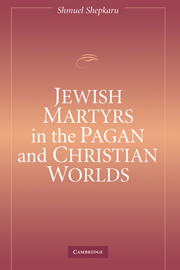Book contents
- Frontmatter
- Contents
- Preface
- Introduction
- 1 Mythic Martyrs
- 2 Between God and Caesar
- 3 “It Is Written in the Law”
- 4 Byzantine Burnt Offerings
- 5 Zarfat
- 6 Ve Ashkenaz: Traditional Manifestations
- 7 Ve Ashkenaz: Manifestations of a Milieu
- 8 Singing in the Fire
- 9 Fire from Heaven
- 10 Shifting Paradigms
- Notes
- Bibliography
- Index
3 - “It Is Written in the Law”
Published online by Cambridge University Press: 17 July 2009
- Frontmatter
- Contents
- Preface
- Introduction
- 1 Mythic Martyrs
- 2 Between God and Caesar
- 3 “It Is Written in the Law”
- 4 Byzantine Burnt Offerings
- 5 Zarfat
- 6 Ve Ashkenaz: Traditional Manifestations
- 7 Ve Ashkenaz: Manifestations of a Milieu
- 8 Singing in the Fire
- 9 Fire from Heaven
- 10 Shifting Paradigms
- Notes
- Bibliography
- Index
Summary
Early rabbinic texts presents the greatest challenge to our methodology of linear history. We know that Tannaitic and Amoraic material take precedence over late midrashic interpretations and commentary and that the Gemara is a commentary on the Mishnah. Yet it is almost impossible to accurately date the material that comprises this vast literature. Further complication adds the inescapable possibility that many of the rabbinic accounts continued to develop before they saw their final appearance in the edited Jerusalem and Babylonian Talmuds. Equally significant is the recognition that the rabbis did not intend to write histories per se. Although presented in historical settings, not much can be said with accuracy about the historicity of the events that the martyrological accounts describe. Discrepancies and contradictions in a single narrative with different versions from different periods are the more obvious reasons against accepting the information at face value.
We would do better, therefore, to treat these stories as martyrologies rather than histories. These martyrologies are dealt with here as the final product of later Talmudic redactors, who relied also on their memory and imagination to complete their work. Without diminishing the importance of the individual account, it is safer to treat the Talmudic stories of martyrdom as a whole and approach them as the production of late-antique editors. Rather than centering on a specific account to speculate how a second-century rabbi understood his martyrological role, or how his contemporaries viewed his death, I will present here the final martyrological picture that later rabbinic redactors put together.
- Type
- Chapter
- Information
- Jewish Martyrs in the Pagan and Christian Worlds , pp. 66 - 106Publisher: Cambridge University PressPrint publication year: 2005

